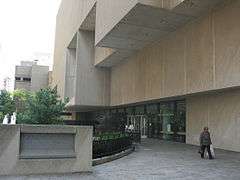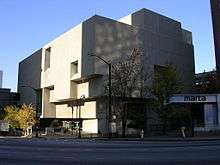Atlanta–Fulton Public Library System
 | |
 | |
| Established | 1902 |
|---|---|
| Location | Atlanta, Georgia |
| Branches | 34 |
| Collection | |
| Size | 2,366,299 items[1] |
| Access and use | |
| Population served |
489,511 cardholders 537,958 (Atlanta), 1,020,104, (Fulton County) |
| Other information | |
| Director | John F. Szabo[2] |
| Website | http://www.afplweb.com/ |
The Atlanta–Fulton Public Library System is a network of public libraries serving the City of Atlanta and Fulton County, both in the U.S. state of Georgia. The system is administered by Fulton County. The system is composed of the Central Library, the Auburn Avenue Research Library on African American Culture and History, and 32 branch libraries.
History
The Young Men's Library Association
The origins of the public library system lie in the Young Men's Library Association (YMLA), a subscription library system established in 1867. The YMLA was open to the public, but only paying members could check out books. Membership was restricted to white men until 1873 when white women were allowed to join. The YMLA system remained the de facto library system of the city for the rest of the century. During the 1890s, however, the YMLA, Andrew Carnegie, and the City of Atlanta, started to work out the details of a new public library in Atlanta.[3]

The Carnegie Library
On March 4, 1902, the first public library, the Carnegie Library, opened on the site of the current Central Library. When the library opened, only the basement, the stacks, and the children's room were completed.[4] The Carnegie Library remained the main library of the system for most of the century. The library was renovated in 1950 and 1966 through city bond funding. Before 1950 the system was referred to as the Carnegie Library, but to commemorate the renovation of the central Carnegie Library the system was renamed the Atlanta Public Library in 1950. In 1977 the Carnegie Library was torn down to make way for the current Central Library. However, the building's architectural bays were preserved, and used to create a monument to higher education in Atlanta.[3]
Expansion of the library system
The Carnegie Library was so successful that within a year after the opening of the library, Carnegie suggested he would give more money to open branch libraries.[5] In 1906 Carnegie formally offered $30,000 for the construction of two branch libraries, as long as the city provided a site and arranged financial support for the library.[6] The Anne Wallace Library, named in honor of the first Carnegie Library librarian, opened in 1909 on the corner of Luckie Street and Merritts Avenue in Northwest Atlanta.[7] Many new branch libraries followed in the years to come. The Ragsdale branch, located in Oakland City, opened in 1912,[8] and in 1913 the Uncle Remus Branch opened in the West End home of Joel Chandler Harris.[9] Over the next century the library system has expanded from four branches in 1913 to the 34 branches operating today. By 1924 the library system had eight branches throughout the city, and by 1967 the system had 19 branches.[7]
City–county relationship
In the first decades of the library system service was maintained for Atlanta residents only, and as a result Fulton County was left without library service. Using Works Progress Administration and city funds, the City of Atlanta and the Fulton County Board of Commissioners signed a contract in 1935 to provide library coverage throughout the county. In 1982, however, Georgia passed a constitutional amendment that allowed the city to transfer control of the system to the county, and in 1983 the system was turned over the county control. To reflect the change in control the system was renamed the Atlanta–Fulton Public Library System.[3]
Black Atlantans and the public library
When the Carnegie Library opened in 1902, blacks were excluded from the library. Activist W. E. B. Du Bois led an unsuccessful campaign for black representation and equal use of the library, or at the very least a branch library for blacks, but the library board rebuffed his efforts. Carnegie had offered funds for a black branch library, but the library system did not use the money until 1921 when the system opened the Auburn Avenue Branch Library, the first branch library for blacks. During segregation two other libraries were opened for the use of blacks. In 1959, Irene Dobbs Jackson, the mother of future Atlanta mayor Maynard Jackson requested a library card for the central library. After days of public furor, the library board voted to allow blacks full access to the library on 19 May 1959. Between 1966 and 1973 the library staff was desegregated.[3]
2008 bond referendum
In 2008 Fulton County voters approved a $275 million library bond referendum, which provides money for renovation and construction of library facilities in Fulton County. The plan includes money for eight new libraries, a new central library, expansions of two libraries, and renovations of 23 branch libraries. Five 25,000-square-foot (2,300 m2) libraries will be built in Alpharetta, Milton, Northwest Atlanta, Wolf Creek, and Stewart-Lakewood. The Alpharetta and Stewart-Lakewood libraries will replace existing 10,000-square-foot (930 m2) libraries, the Northwest Atlanta library will replace three small branch libraries, and the Milton and Wolf Creek libraries will be completely new. A new 10,000-square-foot (930 m2) library will be built in Palmetto/Chattahoochee Hill County, and two new 15,000-square-foot (1,400 m2) libraries will be built in Southeast Atlanta and East Roswell. The Southeast Atlanta library will replace three small branch libraries. In the original Library Facility Master Plan $34 million was allocated to fully restore and upgrade the site. In the final referendum, however, $84 million was provided for the construction of a new 300,000-square-foot (28,000 m2) central library. Finally, the Auburn Avenue Research Library and the South Fulton branch library will be expanded.[10]
Central Library


The Central Library, completed in 1980, was the last building to be designed by Bauhaus-movement architect Marcel Breuer. The building, designed in the brutalist architectural style, is considered a "masterpiece" by architectural experts, such as Barry Bergdoll, the Chief Architectural Curator of the Museum of Modern Art, and is closely related to the Whitney Museum of Art building.[11] Breuer was unable to attend the dedication ceremonies on May 25, 1980, and he died a year later on July 1, 1981 at the age of 81.[12]
The concept for the design dates back to 1969, but the contract was not awarded to Breuer until 1976, because of disputes between the library administration and city government over the bond referendum needed to raise the $18.9 million for construction of the library. Construction began in 1977, and when the structure was completed in 1980 it featured a 300-seat theater, six stories of library space, and a restaurant.[13] The building was built for a capacity of 1,000 users and 1 million volumes. The structures consists of a steel frame and concrete slabs, and the exterior is composed of precast concrete panels that were bush-hammered for texture. Concrete was chosen as the material because concrete allowed for the most economical implementation of the special shapes required for the recessed windows and splayed reveals. The second, third, and fourth stories are connected by a monumental concrete staircase.[13]
Since 1980, however, the state-of-the-art facilities have deteriorated. The theater was closed during the mid-1990s after water from a leaking concrete planter above the theater collapsed parts of the ceiling, but has since been renovated due to recent interest in the building. Although the restaurant was busy and successful during the early years it was closed during the late 1990s.[14] Furthermore, the brutalist architectural style of the library is not fully appreciated in Atlanta. In an effort to mute the harshness of the style, the system spent $5 million to renovate the building in 2002. The money was spent on a new carpet with colorful highlights and more colorful walls. A full renovation would have cost an estimated $34 million.[10] Nonetheless, it still remains unclear as to what will happen to the Breuer building.[15] However, a multi-year preservation effort led by artist, writer and historian, Max Eternity,[16] ignited a renewed interest in the building, and the library was listed on the 2010 World Monuments Watch List of Most Endangered Sites.
Various news outlets, including National Public Radio (NPR), reported in July 2016 that "the Fulton County Board of Commissioners voted unanimously...not to tear down the building."[17]
Branches
- Adams Park Branch
- Adamsville–Collier Heights Branch
- Alpharetta Branch
- Bankhead Courts Branch
- Bowen Homes Branch
- Buckhead Branch
- Carver Homes Branch
- Cleveland Avenue Branch
- College Park Branch
- Dogwood Branch
- East Atlanta Branch
- East Point Branch
- Fairburn Branch
- Georgia Hill Branch
- Hapeville Branch
- Kirkwood Branch
- Martin Luther King Jr., Branch
- Mechanicsville Branch
- Northeast/Spruill Oaks Branch
- Northside Branch
- Ocee Branch
- Palmetto Branch
- Peachtree Branch
- Perry Homes Branch
- Ponce de Leon Branch
- Roswell Branch
- Sandy Springs Branch
- South Fulton Branch
- Southwest Branch
- Stewart-Lakewood Branch
- Thomasville Heights Branch
- Washington Park Branch
- West End Branch
Future Branches
- Wolf Creek Branch
- Southeast Atlanta Branch
References
- ↑ "About AFPLS". Atlanta–Fulton Public Library System. Retrieved 2009-08-12.
- ↑ "Director of the Library". Atlanta–Fulton Public Library System. Retrieved 2009-08-12.
- 1 2 3 4 "100 Years of Library Service". Atlanta–Fulton Public Library System. Retrieved 2011-01-01.
- ↑ Nutting, J R (1902-03-04). "Carnegie's Gift to Atlanta Will Become Active Today". The Atlanta Constitution. p. 1.
- ↑ "Carnegie Will Give More". The Atlanta Constitution. 1903-01-08. p. 11.
- ↑ "$30,000 Given Local Library For Branches". The Atlanta Constitution. 1906-12-02. p. B1.
- 1 2 ""Anne Wallace" Library" opened to the Public". The Atlanta Constitution. 1909-10-31. p. A3.
- ↑ "Oakland City Now Enjoys Branch Library". The Atlanta Constitution. 1912-03-16. p. 5.
- ↑ "Home of Uncle Remus Will Be As Carnegie Library Branch". The Atlanta Constitution. 1913-10-12. p. B3.
- 1 2 "Beauty, truth and bonds: Is library a classy eyesore?". The Atlanta Journal-Constitution. 2008-07-28. p. A1.
- ↑ Lerner, Jonathan (2009-02-18). "Atlanta's urge for a trendy new central library may mean that time is up for Marcel Breuer's final building.". Metropolis Magazine. Archived from the original on 2009-07-04. Retrieved 2009-08-12.
- ↑ http://www.afpls.org/central-hq#History
- 1 2 Hyman, Isabelle (2001). Marcel Breuer, Architect: The Career and the Buildings. Harry N. Abrams, Inc. ISBN 0-8109-4265-8.
- ↑ "Library's lost luster: Twenty years of decay and obsolescence has siphoned Centrals' cultural swagger. A $3 million face-lift may not be enough.". The Atlanta Journal-Constitution. 2001-03-11. p. 1G.
- ↑ Serratore, Angela (2009-03-23). "Threatened in Atlanta: Breuer's Last Design". Preservation Magazine. Retrieved 2009-08-12.
- ↑ "Central Library (preservation blogspot)".
- ↑ http://news.wabe.org/post/fulton-county-votes-not-demolish-central-library
External links
| Wikimedia Commons has media related to Atlanta-Fulton Public Library System. |
- Atlanta–Fulton Public Library System website
- "One of Finest Libraries in South", Atlanta Georgian and News, December 24, 1909 from the Atlanta Historic Newspapers Archive in the Digital Library of Georgia.
Coordinates: 33°45′27″N 84°23′18″W / 33.75753°N 84.388237°W